Robust Optimization of Large-Scale Wind–Solar Storage Renewable Energy Systems Considering Hybrid Storage Multi-Energy Synergy
Abstract
:1. Introduction
1.1. Motivation
1.2. Literature Review
1.3. Contributions
- (1)
- The robust optimization model for hybrid energy storage renewable energy systems integrated with PHES, STPP, HES, and EES is built. The model can accurately describe the production, storage, conversion, and consumption processes of various energy sources, such as electricity, heat, gas, and renewable energy, in the system while effectively reducing the impact of source and load uncertainties on system operation.
- (2)
- The two-stage robust optimization method considering hybrid energy storage and multi-energy synergy is proposed. The method can coordinate and utilize the time-shifting characteristics of multiple energy storage and the multi-energy complementary characteristics of the system and achieve real-time supply and demand matching of the system under uncertainty through multi-energy synergy.
- (3)
- The original problem is transformed into the two-stage main problem and sub-problem for iterative solution based on the CCG algorithm, and the optimal system operation strategy with economy and robustness is finally obtained. The results show that the optimal scheduling strategy can improve the flexibility and renewable energy consumption efficiency of the system.
2. System Description
3. Model Formulation
3.1. System Operating Costs
3.2. Energy Balance Constraints
3.3. Renewable Power Generation Constraints
3.4. Hybrid Energy Storage Constraints
3.4.1. Operation Constraints on the PHES
3.4.2. Operation Constraints on the STPP
3.4.3. Operation Constraints on the HES
3.4.4. Operation Constraints on the EES
3.5. Backup Heat Sources Constraints
3.6. Objective Function
4. Solution Methodology
5. Case Testing Results
5.1. Case Parameter Settings
5.2. Economic Operation Strategy of the System
5.3. Comparison of Deterministic Optimization Result and Robust Optimization Result
- Scenario 1: The deterministic optimization model has the same periods as the robust optimization model for the worst case scenarios for wind power and PV power; the deterministic optimization model has the same periods as the robust optimization model for the worst case scenarios for the electric load of 6–8 h, 11–14 h, and 18–20 h and the periods for the thermal load of 6–8 h and 18–24 h;
- Scenario 2: The worst case scenarios in the deterministic optimization model are 6 h and 11–15 h for wind power and 11–15 h for PV power; the worst case scenarios in the deterministic optimization model are the same as in the robust optimization model for electric and thermal load;
- Scenario 3: The deterministic optimization model has the same periods for the worst case scenarios for wind, PV output, electric load, and thermal load as the robust optimization model.
5.4. Performance Analysis of Different Energy Storage Configuration Schemes
- Case 1: The PHES, EES, STPP, and HES are not considered;
- Case 2: Consider the PHES and STPP, without the EES and HES;
- Case 3: Consider the EES and HES, without the PHES and STPP;
- Case 4: Consider the PHES, STPP, EES, and HES, which is the system proposed in this paper.
6. Conclusions
Author Contributions
Funding
Institutional Review Board Statement
Informed Consent Statement
Data Availability Statement
Conflicts of Interest
References
- Zhao, X.; Ma, X.; Chen, B.; Shang, Y.; Song, M. Challenges toward Carbon Neutrality in China: Strategies and Countermeasures. Resour. Conserv. Recycl. 2022, 176, 105959. [Google Scholar] [CrossRef]
- Sen, S.; Ganguly, S. Opportunities, Barriers and Issues with Renewable Energy Development—A Discussion. Renew. Sustain. Energy Rev. 2017, 69, 1170–1181. [Google Scholar] [CrossRef]
- Zhai, Q.; Li, X.; Lei, X.; Guan, X. Transmission Constrained UC with Wind Power: An All-Scenario-Feasible MILP Formulation with Strong Nonanticipativity. IEEE Trans. Power Syst. 2017, 32, 1805–1817. [Google Scholar] [CrossRef]
- Zhou, Y.; Zhao, J.; Zhai, Q. 100% Renewable Energy: A Multi-Stage Robust Scheduling Approach for Cascade Hydropower System with Wind and Photovoltaic Power. Appl. Energy 2021, 301, 117441. [Google Scholar] [CrossRef]
- Hao, J.; Chen, L.; Zhang, N. A Statistical Review of Considerations on the Implementation Path of China’s “Double Carbon” Goal. Sustainability 2022, 14, 11274. [Google Scholar] [CrossRef]
- Vasilkov, O.S.; Dobysh, V.S. Features of Application Hybrid Energy Storage in Power Supply Systems. In Proceedings of the 2019 IEEE Conference of Russian Young Researchers in Electrical and Electronic Engineering (EIConRus), Saint Petersburg and Moscow, Russia, 28–31 January 2019; pp. 728–730. [Google Scholar]
- Javed, M.S.; Zhong, D.; Ma, T.; Song, A.; Ahmed, S. Hybrid Pumped Hydro and Battery Storage for Renewable Energy Based Power Supply System. Appl. Energy 2020, 257, 114026. [Google Scholar] [CrossRef]
- Lin, X.; Zamora, R. Controls of Hybrid Energy Storage Systems in Microgrids: Critical Review, Case Study and Future Trends. J. Energy Storage 2022, 47, 103884. [Google Scholar] [CrossRef]
- Alnaqbi, S.A.; Alasad, S.; Aljaghoub, H.; Alami, A.H.; Abdelkareem, M.A.; Olabi, A.G. Applicability of Hydropower Generation and Pumped Hydro Energy Storage in the Middle East and North Africa. Energies 2022, 15, 2412. [Google Scholar] [CrossRef]
- Zhao, Z.; Yuan, Y.; He, M.; Jurasz, J.; Wang, J.; Egusquiza, M.; Egusquiza, E.; Xu, B.; Chen, D. Stability and Efficiency Performance of Pumped Hydro Energy Storage System for Higher Flexibility. Renew. Energy 2022, 199, 1482–1494. [Google Scholar] [CrossRef]
- Wang, S.; Sun, W. Capacity Value Assessment for a Combined Power Plant System of New Energy and Energy Storage Based on Robust Scheduling Rules. Sustainability 2023, 15, 15327. [Google Scholar] [CrossRef]
- Baindu Gobio-Thomas, L.; Darwish, M.; Stojceska, V. Review on the Economic Impacts of Solar Thermal Power Plants. Therm. Sci. Eng. Prog. 2023, 46, 102224. [Google Scholar] [CrossRef]
- Dong, X.; Wu, J.; Xu, Z.; Liu, K.; Guan, X. Optimal Coordination of Hydrogen-Based Integrated Energy Systems with Combination of Hydrogen and Water Storage. Appl. Energy 2022, 308, 118274. [Google Scholar] [CrossRef]
- Arsad, A.Z.; Hannan, M.A.; Al-Shetwi, A.Q.; Mansur, M.; Muttaqi, K.M.; Dong, Z.Y.; Blaabjerg, F. Hydrogen Energy Storage Integrated Hybrid Renewable Energy Systems: A Review Analysis for Future Research Directions. Int. J. Hydrogen Energy 2022, 47, 17285–17312. [Google Scholar] [CrossRef]
- Worku, M.Y. Recent Advances in Energy Storage Systems for Renewable Source Grid Integration: A Comprehensive Review. Sustainability 2022, 14, 5985. [Google Scholar] [CrossRef]
- Zheng, L.; Wen, Z.; Qiu, Z.; Liu, F.; Guo, J.; Luo, S. Low-Carbon Optimized Operation of an Integrated Energy System that Takes into Account Solar Thermal Power Plants and Hydrogen Storage. Electrical Measurement & Instrumentation. 2022, pp. 1–9. Available online: https://kns.cnki.net/kcms/detail/23.1202.TH.20220530.1813.003.html (accessed on 10 November 2023).
- Awan, A.B.; Zubair, M.; Sidhu, G.A.S.; Bhatti, A.R.; Abo-Khalil, A.G. Performance Analysis of Various Hybrid Renewable Energy Systems Using Battery, Hydrogen, and Pumped Hydro-Based Storage Units. Int. J. Energy Res. 2019, 43, 6296–6321. [Google Scholar] [CrossRef]
- Ma, T.; Yang, H.; Lu, L. Feasibility Study and Economic Analysis of Pumped Hydro Storage and Battery Storage for a Renewable Energy Powered Island. Energy Convers. Manag. 2014, 79, 387–397. [Google Scholar] [CrossRef]
- Zhang, W.; Maleki, A.; Rosen, M.A.; Liu, J. Optimization with a Simulated Annealing Algorithm of a Hybrid System for Renewable Energy Including Battery and Hydrogen Storage. Energy 2018, 163, 191–207. [Google Scholar] [CrossRef]
- Wang, S.; Wu, X.; Jafarmadar, S.; Singh, P.K.; Khorasani, S.; Marefati, M.; Alizadeh, A. Numerical Assessment of a Hybrid Energy System Based on Solid Oxide Electrolyzer, Solar Energy and Molten Carbonate Fuel Cell for the Generation of Electrical Energy and Hydrogen Fuel with Electricity Storage Option. J. Energy Storage 2022, 54, 105274. [Google Scholar] [CrossRef]
- Jiao, Y.; Månsson, D. Greenhouse Gas Emissions from Hybrid Energy Storage Systems in Future 100% Renewable Power Systems—A Swedish Case Based on Consequential Life Cycle Assessment. J. Energy Storage 2023, 57, 106167. [Google Scholar] [CrossRef]
- Shen, W.; Zeng, B.; Zeng, M. Multi-Timescale Rolling Optimization Dispatch Method for Integrated Energy System with Hybrid Energy Storage System. Energy 2023, 283, 129006. [Google Scholar] [CrossRef]
- Qiu, Y.; Li, Q.; Ai, Y.; Chen, W.; Benbouzid, M.; Liu, S.; Gao, F. Two-Stage Distributionally Robust Optimization-Based Coordinated Scheduling of Integrated Energy System with Electricity-Hydrogen Hybrid Energy Storage. Prot. Control Mod. Power Syst. 2023, 8, 33. [Google Scholar] [CrossRef]
- Rasool, M.H.; Taylan, O.; Perwez, U.; Batunlu, C. Comparative Assessment of Multi-Objective Optimization of Hybrid Energy Storage System Considering Grid Balancing. Renew. Energy 2023, 216, 119107. [Google Scholar] [CrossRef]
- Zeng, B.; Zhao, L. Solving Two-Stage Robust Optimization Problems Using a Column-and-Constraint Generation Method. Oper. Res. Lett. 2013, 41, 457–461. [Google Scholar] [CrossRef]
- Roald, L.A.; Pozo, D.; Papavasiliou, A.; Molzahn, D.K.; Kazempour, J.; Conejo, A. Power Systems Optimization under Uncertainty: A Review of Methods and Applications. Electr. Power Syst. Res. 2023, 214, 108725. [Google Scholar] [CrossRef]
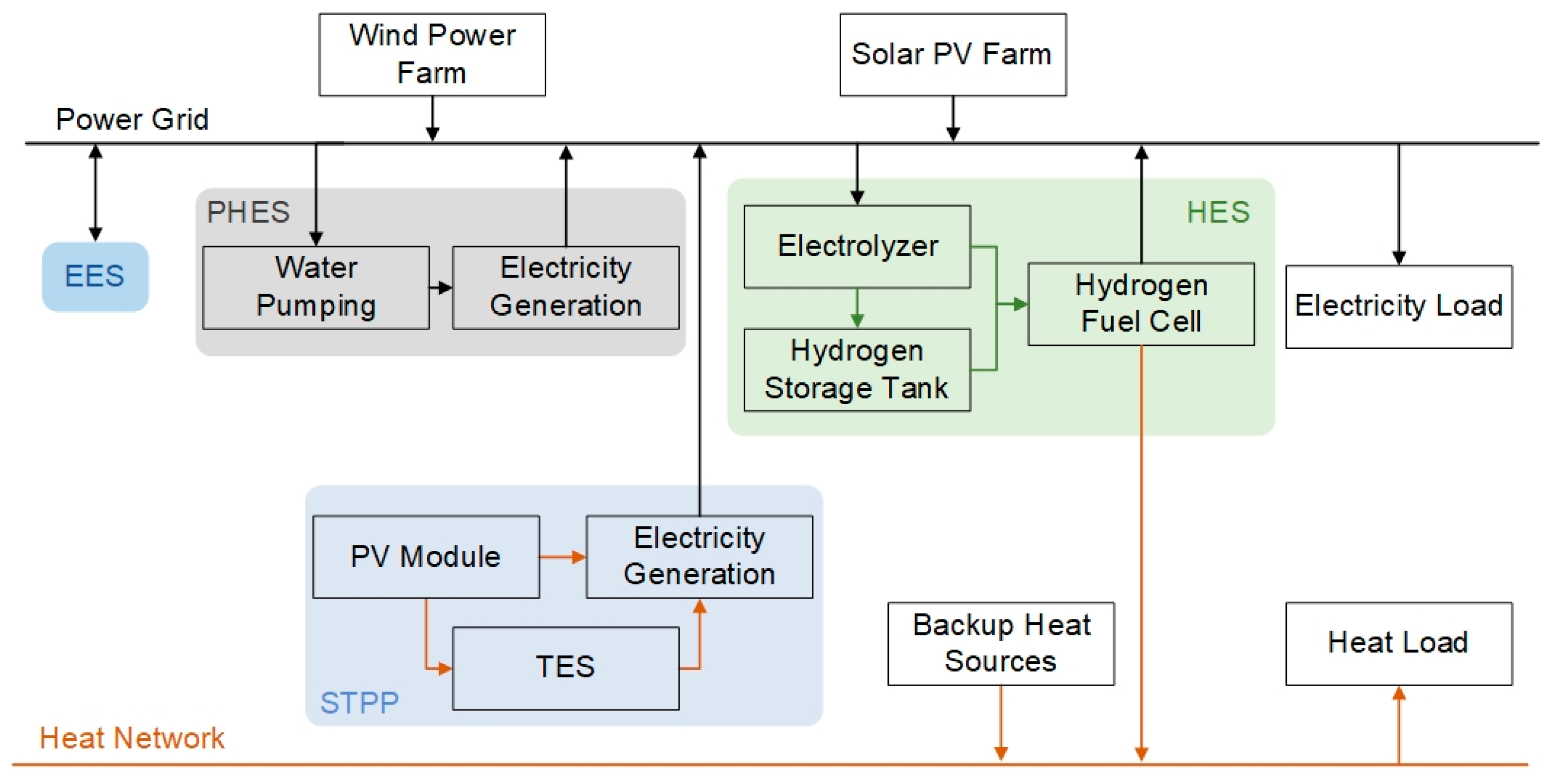
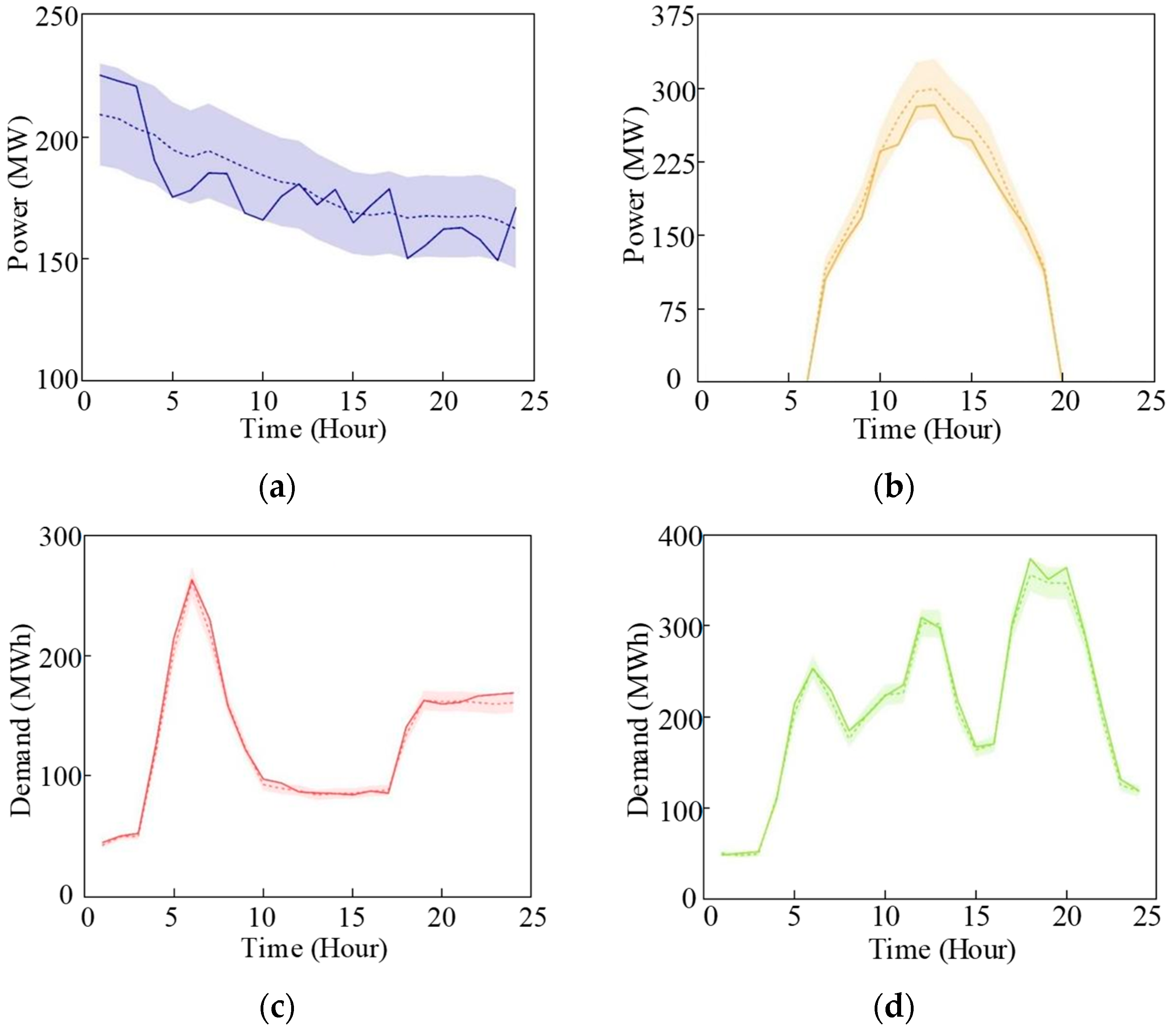

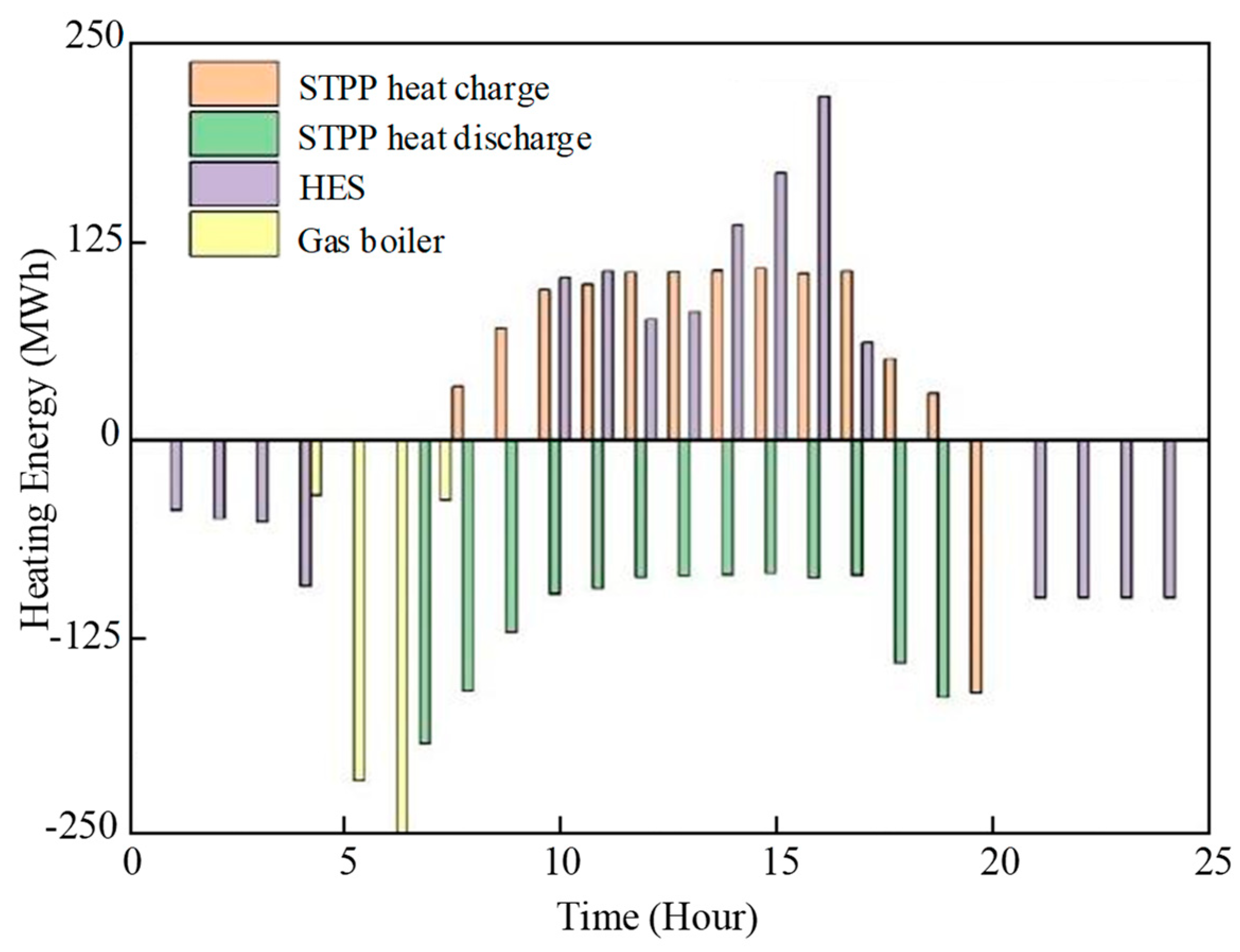
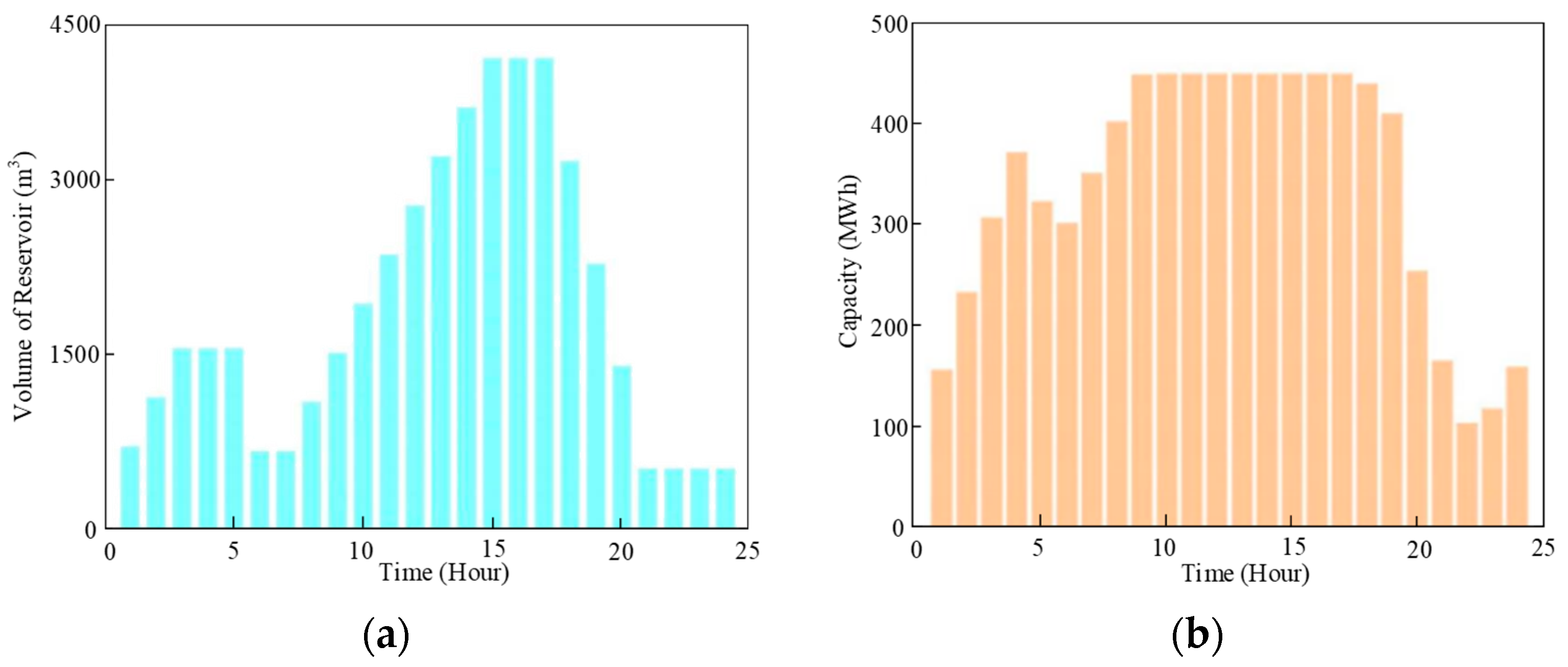

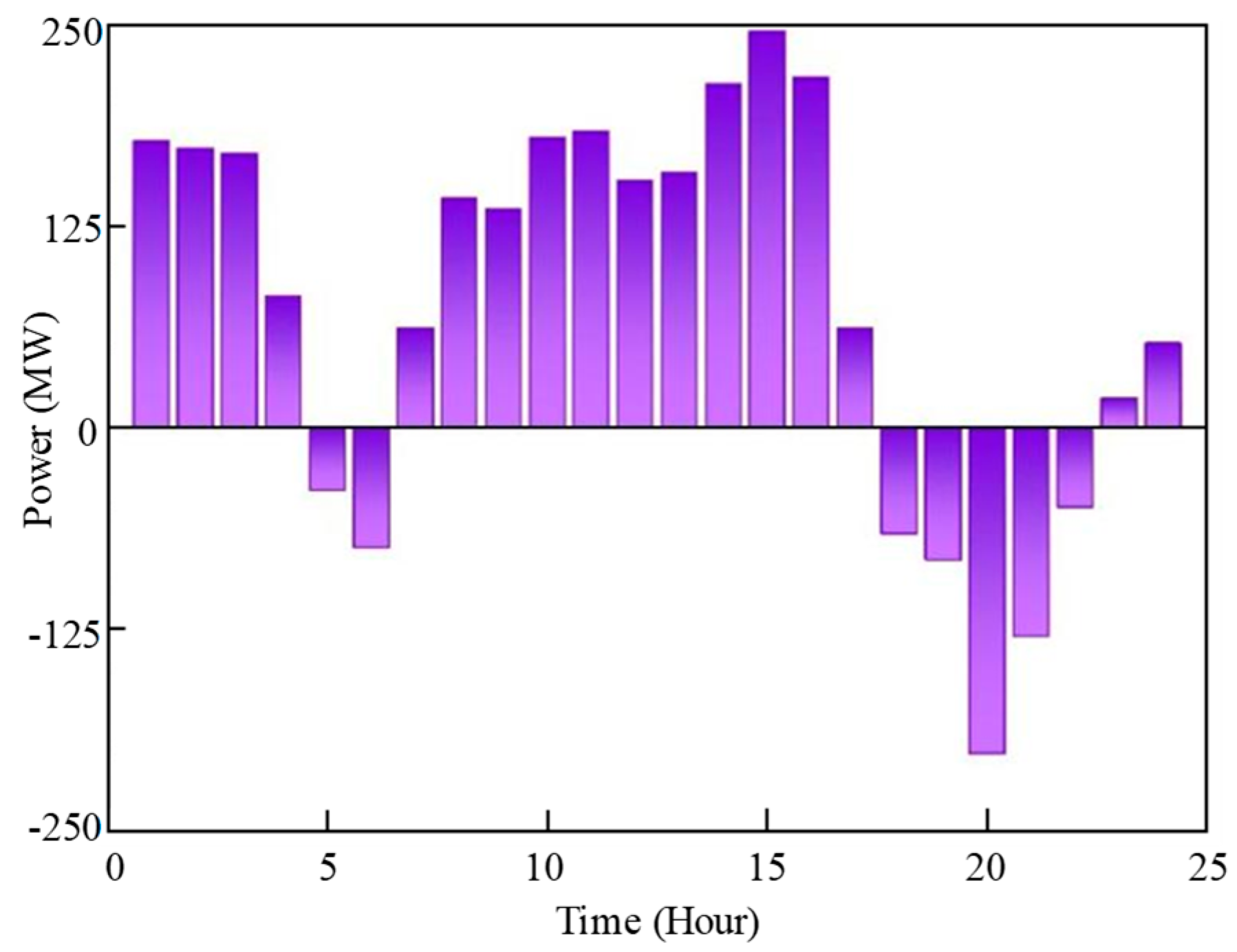
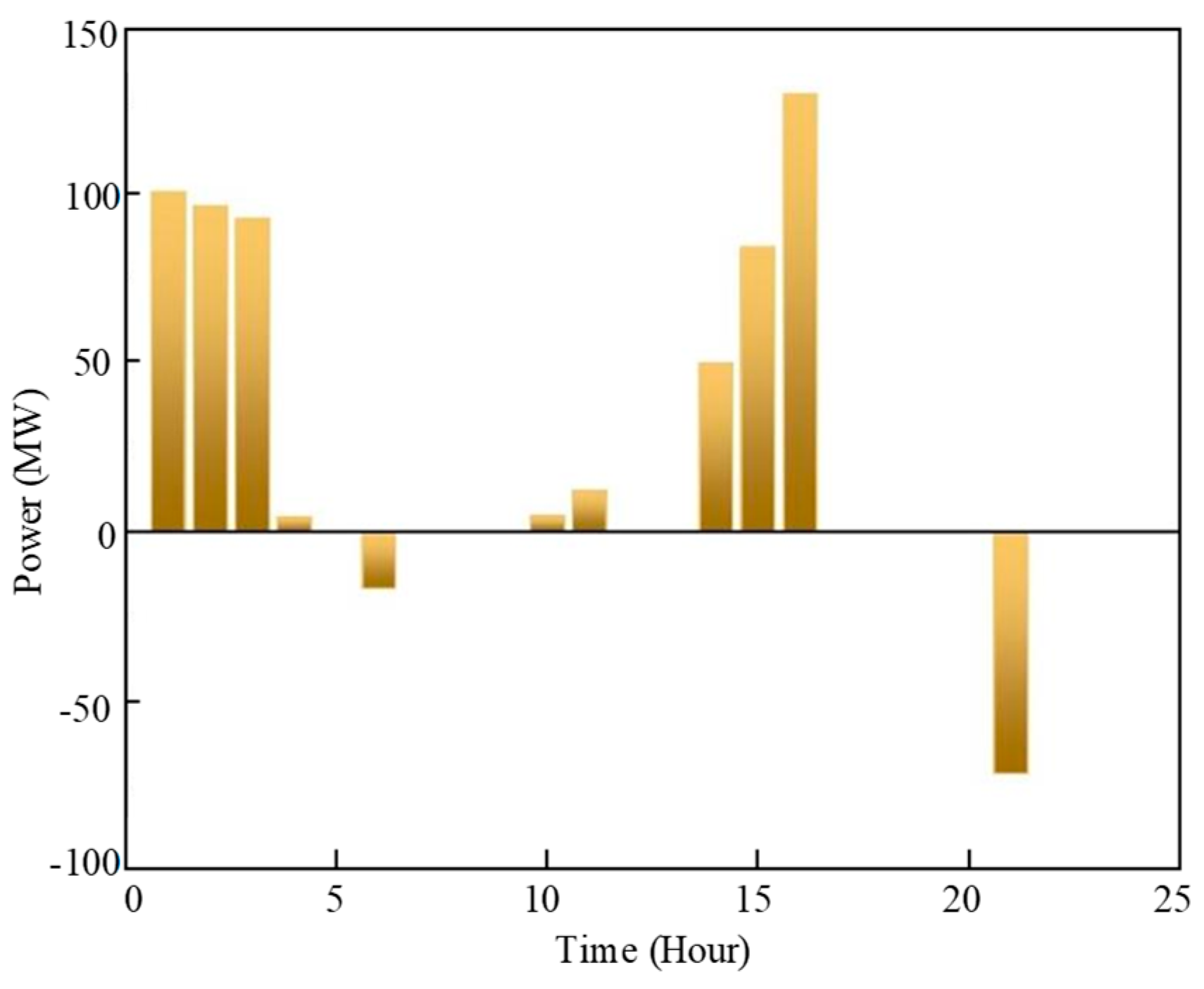

| Reference | Hybrid Energy Storage | Uncertainty | Method | |||
|---|---|---|---|---|---|---|
| EES | HES | PHES | STPP | |||
| Zheng et al. [16] | √ 1 | √ | × 2 | Mixed integer linear programming | ||
| Javed et al. [7] | √ | √ | × | Rule-based operation | ||
| Awan et al. [17] | √ | √ | √ | × | Simulation | |
| Ma et al. [18] | √ | √ | × | Real project analysis | ||
| Zhang et al. [19] | √ | √ | × | Simulated annealing algorithm | ||
| Wang et al. [20] | √ | √ | √ | × | Numerical simulation | |
| Jiao et al. [21] | √ | √ | √ | × | Consequential life cycle assessment | |
| Shen et al. [22] | √ | √ | √ | Model predictive control | ||
| Qiu et al. [23] | √ | √ | √ | CCG | ||
| Rasool et al. [24] | √ | √ | √ | Genetic algorithm | ||
| This paper | √ | √ | √ | √ | √ | CCG |
| Nomenclature | Nomenclature | ||
|---|---|---|---|
| Abbreviation | Self-loss coefficient of the TES | ||
| CCG | Column constraint generation | Charging and discharging heat efficiencies of the TES | |
| EES | Electrochemical energy storage | Thermoelectric conversion efficiency | |
| HES | Hydrogen energy storage | Electrical/thermal conversion efficiency of hydrogen fuel cells | |
| O&M | Operation and maintenance | Efficiency of hydrogen charge/discharge | |
| PHES | Pumped hydro energy storage | Charging/discharging efficiencies of EES | |
| PV | Photovoltaic | Heat generation efficiency of the gas boiler | |
| STPP | Solar thermal power plant | DOD | Maximum depth of EES discharge |
| TES | Thermal energy storage | Variables | |
| Parameters | Electricity stored in the EES | ||
| Direct radiance factor of the solar energy | Hydrogen power obtained from the electrolyzer | ||
| Rated capacity of the EES | Power of hydrogen stored in the hydrogen storage tank | ||
| Heat load demand of the system | Obtained thermal energy of the PV module in STPP | ||
| Output upper limit of the TES supplied directly to the heat load | Heat stored in the TES | ||
| Upper thermal energy output limit of the hydrogen fuel cell | Charging and discharging heat of the TES | ||
| Electrical load demand of the system | Heat supplied by the collector to the electricity generation unit | ||
| Rated charge/discharge power of the EES | Heat discarded in TES | ||
| Upper power generation output/input limit of the hydrogen fuel cell/electrolyzer | Heat supplied by the TES to the electricity generation unit | ||
| Predicted output power of wind and PV power generation | Power of hydrogen charge | ||
| Output upper limit of the electricity generation unit | Input power of the electrolyzer | ||
| Rated power of the pump and generator of PHES | Generating power of STPP | ||
| Lower limit of the output of the pump and generator of PHES | Charging/discharging power of EES | ||
| Area of the mirror farm | Output power of wind power/PV | ||
| Minimum and maximum capacity of the reservoir in PHES | Electrical and thermal output power of the hydrogen fuel cell | ||
| Minimum/maximum value of natural gas consumed by the gas boiler | Pumping and generating power of the PHES | ||
| Unit operation and maintenance costs of wind power/PV/STPP/hydrogen fuel cell/electrolyzer/PHES/EES/backup heat sources | Charging and discharging power of the EES | ||
| Density of water | Consumed natural gas of the gas boiler | ||
| Acceleration of gravity | Upper reservoir capacity of PHES | ||
| Head of the water in PHES | State variable of hydrogen charge/discharge | ||
| Photothermal conversion efficiency | Pumping/generation state variable | ||
| Allowable deviation in the PHES/EES | Charging/discharging state variable of EES |
| Device | Parameter/Unit | Value |
|---|---|---|
| Wind power farm | /(RMB/MW) | 50 |
| Solar PV farm | /(RMB/MW) | 50 |
| STPP | /(RMB/MW) | 15 |
| /MW | 144 | |
| /MWh | 192 | |
| HES | /(RMB/MW) | 18 |
| /(RMB/MW) | 20 | |
| /MW | 125 | |
| /MW | 220 | |
| /MWh | 100 | |
| EES | /(RMB/MW) | 10 |
| DOD | 0.8 | |
| /MWh | 454 | |
| /MW | 125 | |
| PHES | /(RMB/MW) | 5 |
| /m3 | 1500 | |
| /m3 | 300 | |
| /MW | 77 | |
| /MW | 58 | |
| Gas boiler | /(RMB/MW) | 73 |
| Scenario | System Operating Cost/×104 RMB |
|---|---|
| Scenario 1 | 44.13 |
| Scenario 2 | 44.09 |
| Scenario 3 | 44.15 |
| Robust optimization result | 44.15 |
| Case | System Operating Cost/×104 RMB |
|---|---|
| Case 1 | 137.47 |
| Case 2 | 66.80 |
| Case 3 | 85.34 |
| Case 4 | 44.15 |
Disclaimer/Publisher’s Note: The statements, opinions and data contained in all publications are solely those of the individual author(s) and contributor(s) and not of MDPI and/or the editor(s). MDPI and/or the editor(s) disclaim responsibility for any injury to people or property resulting from any ideas, methods, instructions or products referred to in the content. |
© 2023 by the authors. Licensee MDPI, Basel, Switzerland. This article is an open access article distributed under the terms and conditions of the Creative Commons Attribution (CC BY) license (https://creativecommons.org/licenses/by/4.0/).
Share and Cite
Xiao, B.; Gao, Z.; Peng, H.; Chen, K.; Li, Y.; Liu, K. Robust Optimization of Large-Scale Wind–Solar Storage Renewable Energy Systems Considering Hybrid Storage Multi-Energy Synergy. Sustainability 2024, 16, 243. https://doi.org/10.3390/su16010243
Xiao B, Gao Z, Peng H, Chen K, Li Y, Liu K. Robust Optimization of Large-Scale Wind–Solar Storage Renewable Energy Systems Considering Hybrid Storage Multi-Energy Synergy. Sustainability. 2024; 16(1):243. https://doi.org/10.3390/su16010243
Chicago/Turabian StyleXiao, Bin, Zhenxin Gao, Huaiwu Peng, Kang Chen, Yang Li, and Kun Liu. 2024. "Robust Optimization of Large-Scale Wind–Solar Storage Renewable Energy Systems Considering Hybrid Storage Multi-Energy Synergy" Sustainability 16, no. 1: 243. https://doi.org/10.3390/su16010243
APA StyleXiao, B., Gao, Z., Peng, H., Chen, K., Li, Y., & Liu, K. (2024). Robust Optimization of Large-Scale Wind–Solar Storage Renewable Energy Systems Considering Hybrid Storage Multi-Energy Synergy. Sustainability, 16(1), 243. https://doi.org/10.3390/su16010243






